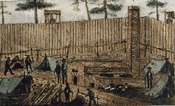 |
Confederate P.O.W. Camps |
|
State War Records |
| AL - AK - AZ - AR - CA - CO - CT - DE - FL - GA - HI - ID - IL - IN - IA - KS - KY - LA - MA - MD - ME - MI - MN - MS - MO - MT - NE - NV - NH - NJ - NM - NY - NC - ND - OH - OK - OR - PA - RI - SC - SD - TN - TX - UT - VT - VA - WA - WV - WI - WY |
Salisbury Prison
Search, View, Print Union & Confederate Civil War Prisoner of War Records, 1861-1865

Confederate 1861-1865
Salisbury, North Carolina
When Gov. Henry T. Clark of North Carolina shopped for a new prison camp, the abandoned cotton factory in downtown Salisbury seemed like a good deal. It was on a rail line, facilitating prisoner movement, and the brick factory and accompanying wooden boarding houses were deemed sufficient for the anticipated 2,000 inmates. Wells provided fresh water, and the local countryside was rich in produce, making provisioning easy. Most important, the price was right. The factory's owner wanted only $15,000 for the 11 acre complex, which included $500 worth of machinery. He was also willing to accept payment in Confederate bonds. And while $2,000 was needed for iron bars and other security measures, Clark was assured that the prison could be resold after the war for $30,000 to $50,000, bringing a tidy profit. So on November 2, the Confederate government purchased the complex.
The prison had a large 4-story, brick building and 6 small cottages on 16 acres, heavily shaded by oak trees. It was built in 1845 by local resident Maxwell Chambers. The site had been sitting dormant for a number of years until it was pourchased by the Confederate government. It was estimated that the buildings would hold 1,500 to 2,000 prisoners. The site also sat at the crossroads of North Carolina's major railroad lines, and in an area rich in produce.
Surrounded by a simple board fence, Salisbury Prison promised to be a prison for Confederate soldiers who had committed military offenses, deserters, spies, and Southern citizens suspected of disloyalty. On December 12, with the prison still not fully completed, the first Union prisoners arrived at the prison on December 12, captuerd at the battle of 1st Manassas/Bull Run. By spring of 1862, the prison would reach a population of 1,700 prisoners. Under the cartel agreement, which was the prisoner exchange, the prison population dropped to about 800 prisoners.
The prison was enclosed by an 8-foot high fence with a parapet about 4-feet high running along the outside for guards to patrol along. The entrance was guarded by 2 cannon wit other cannon positioned along the portholes in the fence, with a full sweep of the inside of the compound. The prison headquarters was on the north side of the entrance gates, outside of the compound. The main building was located toward the southeast corner of the compound. The cottages were located in groups of 3 at right angles a short distance from the main building, toward the center of the compound. there was a blacksmith shop toward the front gate and later served as the "deadhouse".
Col. George C. Gibbs was named as the first commandant of the prison. He was replaced by Capt. A.C. Godwin, then by Capt. Henry McCoy.There were a number of changes in command at the prison through the remainder of the war. Capt. Swift Galloway took over as commandant in 1863, followed by Col. John A. Gilmore, and then Maj. John H. Gee. By September 1864, Gee was told to prepare the prison for a large group of prisoners in October. Improvements were started at the prison immediately. Before they could be finished, a group of 5,000 prisoners arrived on October 5. In the following weeks, more prisoners arrived and by the end of October, the prison population had reached 10,321. By the end of 1864, Gee was finally able to transfer all the officer prisoners to Danville Prison, thus providing more room for the remaining prisoners. After the war ended, gee was arrested by Federal authorities because of the conditions that the Union prisoners had to endure. He was tried by a military commission in February 1866 on the charge of cruelty and conspiracy regarding his management of Salisbury Prison. After a 5-month trail, he was aquitted on all charges and released.
 This is a Plat of the Prison Property Owned by the Confederacy. Enlarge Image |
In January 1865, Gee was replaced by Gen. Bradley Johnson. On February 22, all prisoners not too sick or weak to move, left the prison for a general prisoner exchange. The column of more than 2,800 prisoners began a 51-mile march to Greensboro, North Carolina. Of the over than 2,800 prisoners that left, only 1,800 made it to Greensboro. Over 200 were left at Lexington and 500 were abandoned along the road the following day. All together, nearly 1,000 prisoners fell by the wayside, too weak to continue, or died along the way.
In the following days, more groups of prisoners continued to leave the prison in a similar manner until 5,149 prisoners were evacuated. When they arrived at Greensboro, they were sent by train to Wilmington, where they were allowed to enter Union lines on March 2. By the end of March, only 500 prisoners were left at the prison.
When the Union army arrived at the prison on April 12, they found that the prison was being used as a storage depot by the Confederate army. When the Union army finally left Salisbury, the compound was set on fire.
LIFE & CONDITIONS:
Conditions were good until late 1863. Food and room were plentiful, and the prisoners even formed baseball teams. Reasonable rations, decent water supply, and good sanatation werte other good conditions that the prisoners cherished. Women from the local towns were allowed to work in the prison and sometimes even brought homecooked meals to the prisoners.The conditions at the prison had remained fairly stable up into 1864. The prison population reached to over 10,321 by the end of 1864. The prisoners were seperated by rank at the prison. The officers were kept on the eastern side, where most of the buildings were, and the enlisted were placed into the western side. With the growing prison crisis and increasing prison populations, the conditions at all of the prisons went down hill fast. Conditions became so bad in 1864 that the Confederate War department sent an additional 1,500 guards to help control the prison. Confederate and Union prisoners were in a continuing feud that led to many gang fights. There were also numerous escape attempts made during this time. A lack of shelter caused a lot of fights. Nearly 50% of the prisoners did not have any shelter.
Those without a shelter often burrowed into the ground for protection. before long, the entire compound was honey-combed with holes. A lack of medical supplies added to the pandimonium inside the prison.
Supplies for the prison became unattainable due to war shortages. This made the prisoners to intensely suffer from hunger. Within a short time, the wells that supplied the water became contaminated and typhoid broke out at the prison. The prisoners began dying at an alarming rate, sometimes up to 75 men a day. The dead bodies were placed in a "deadhouse" each morning. They stayed there until the bodies could be buried later on. A wagon would take a load of bodies to a nearby cornfield, where the bodies were put in a huge pit. The pit measured 6-feet wide, 4-feet deep, and 60-yards long. By February 1865, there would be 18 of these burial pits.
The food supply became almost nonexistent by the end of 1864. Rations were issued irregularly and usually consisted of Indian cornbread and a weak cowpea soup.
